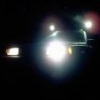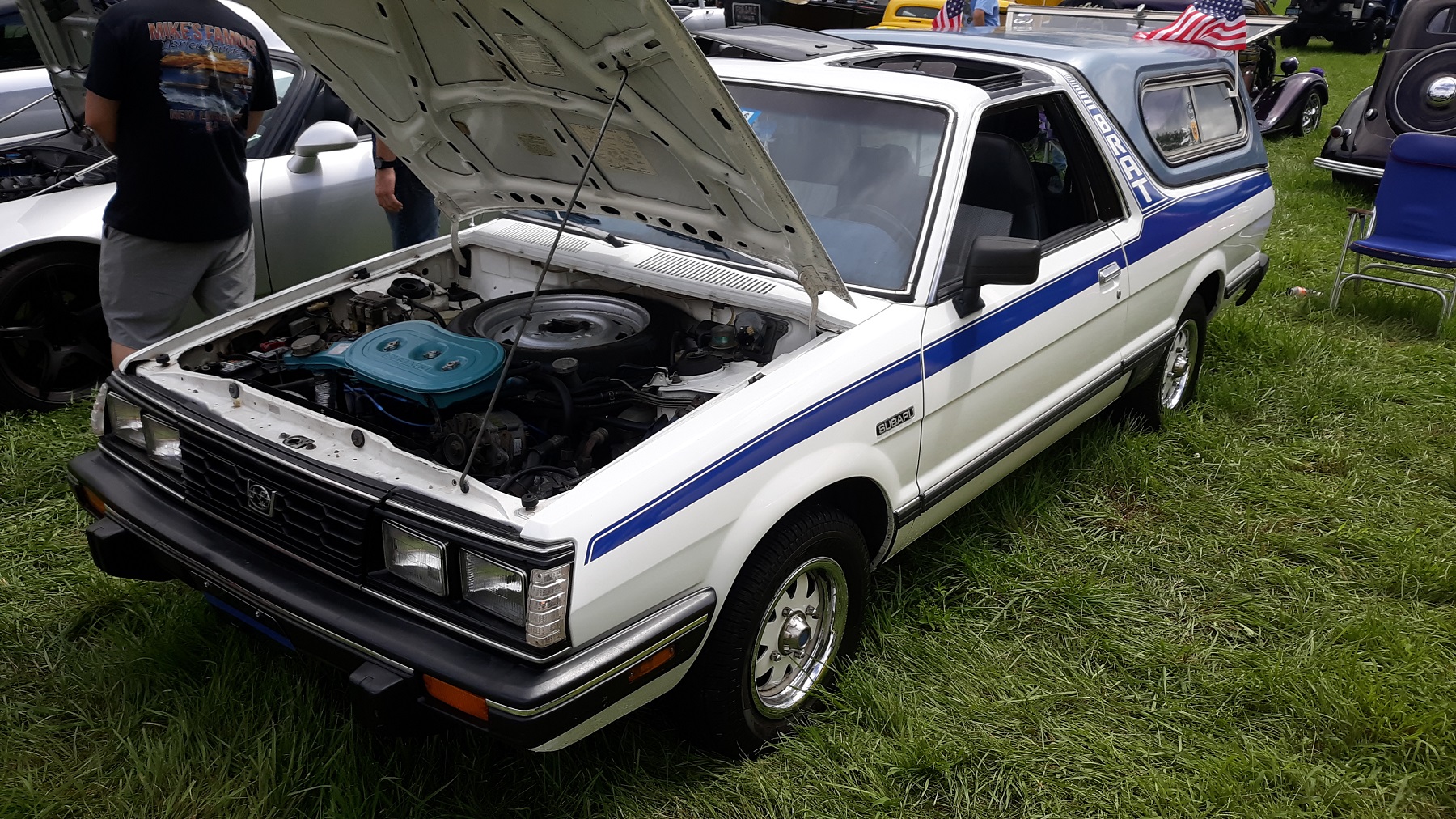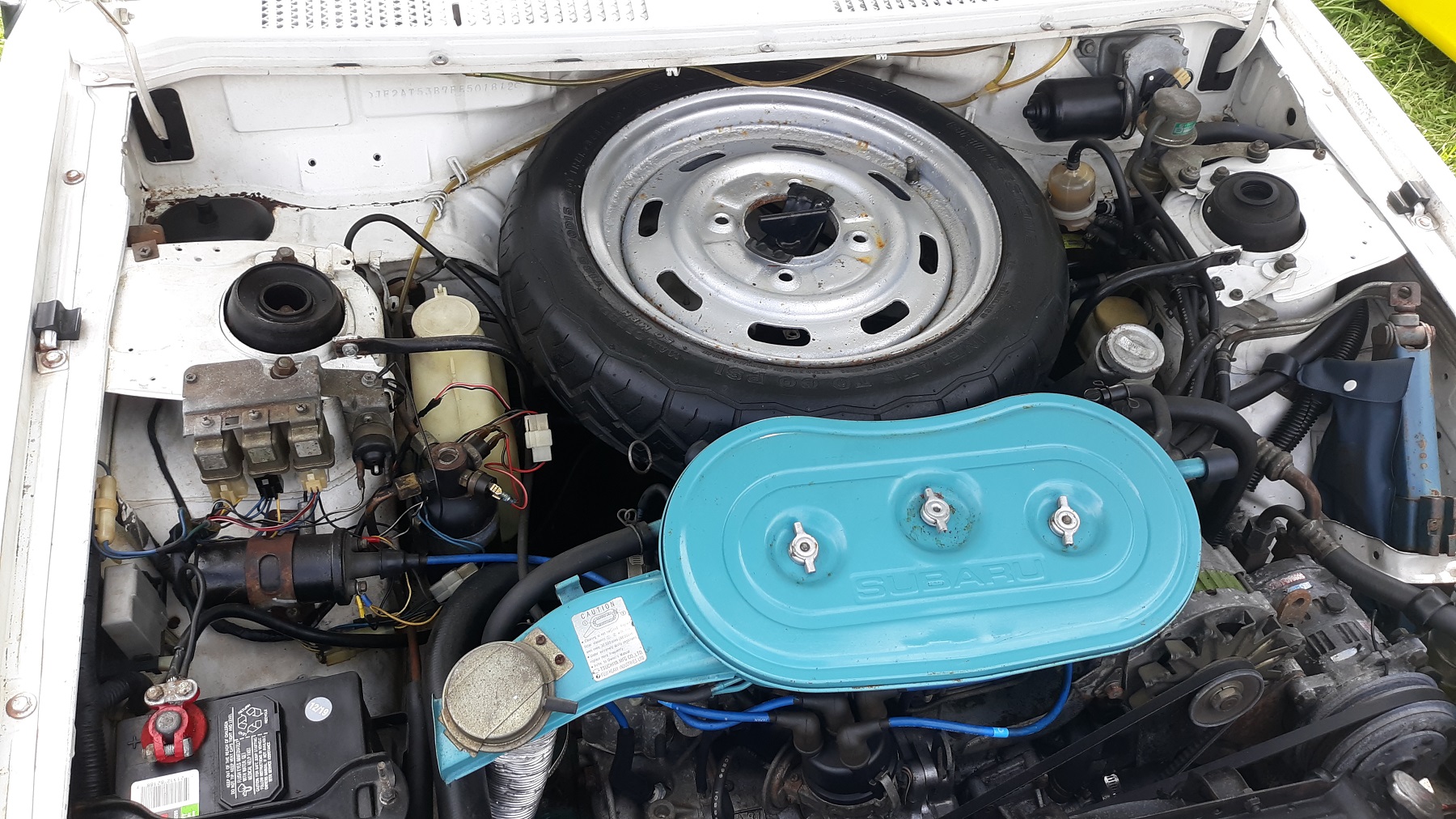Leaderboard
Popular Content
Showing content with the highest reputation on 08/19/23 in all areas
-
1 point
-
Some last minute rust repair before the last trip I forgot to post. Black Outback's muffler is quite rusty and started leaking. This is after hitting it with the wire wheel, a big chunk of it evaporated. Welded on a patch. High temp paint. Maybe a waste of time but did make the exhaust significantly quieter. On to the Impreza. Most of the fab work is done. Bumper and skids about as welded as they can get on the car. Made mounts for the stock turn signals (without those they blink fast). They'll be mostly behind a sheet metal panel below the bumper. B made fan mounts, only have one right now but you can see the tabs for both sides. Headlights and a few other things I just set in place for pictures. Made mounts for light bars just under the headlights. B figured out radiator mounting a while back. Obtained the right section of harness for the PS, alt, and AC compressor. B mounted the airbox a while back, I popped another hole in it. Might epoxy a tube on that eventually, still need to cut a hole in the hood scoop blockoff panel for those. I had the exhaust mostly laid out and then B reminded me about the gas tank guard. Pressed a divot in the skinny muffler to fit that. Probably won't restrict flow too much. Also made the ends out of round but phased 90 from the middle (you can kind of see in picture below). Skinny muffler in place. If/when I fab a rear bumper I can raise the big muffler an inch or two. Front portion of exhaust is basically done. Going to add a flange/gasket where this will meet up with the skinny muffler. If anyone has a recommendation on a 2.5" flange/gasket I'm all ears. Have to remove the various crossmembers/skids/bumper for finish welding and paint. Still need to find power steering lines and reservoir (2015ish H6 Outback) if anyone has a line on those. Also need to swap in DBW gas pedal and manual brake/clutch pedals and clutch hydraulics. Most of what's left is wiring. I think I have that mostly figured out. Might mount the Haltech where the passenger air bag was and make that panel easily removable.1 point
-
Okay, bear with me as this is my first write up, but here are the simplified steps to converting an EA81 from a Hitachi carburetor to a Weber carb... feel free to add anything i missed, and as always, referr to Jezek's thread if you dont find what your looking for here. EA81 Hitachi to Weber 32/36 Conversation NOTES: These instructions are for a no AC, non power steering 1.8L EA81; variations may apply to those engines equipped with said add ons. The author takes no responsibility for misinterpretation of these directions and the consequences thereof. These are general guide lines that apply to all older Subarus equipped with the 1.8 liter EA81 engine. However, most steps will apply to the EA82 engine. There are some unique differences between the EA82 and the EA81, so if you're doing a swap on an EA82, please go to JesZeks thread here:http://www.ultimatesubaru.org/forum/topic/71510-ideas-on-swaping-a-weber-carb-on-ea82%C2%B4s/ Even if you are doing a swap on a EA81, I highly recommend looking at his thread, as he includes things which I have not covered in this write up, such as fabricating and installing a free flow muffler. Terms: PCV = Positive Crankcase Ventilation valve. The PCV vents harmful gasses away from the engine. It is found on the backside of the intake manifold next to the EGR. EGR = Exhaust Gas Readmission valve. The EGR is an emission valve used to recirculated unburnt fuel vapors from the exhaust ASV = Air Suction Valve. A useless emissions system that is supposed to suck cool air from the air box into the catalyst converter. It is easily identified by the large plastic silencers that attach to a shiny pipe that screws into each head. 12V Ignition Source: Any wire that has no more than 12 volts running through it when the ignition is on. Throttle wheel: This is the part that the throttle cable (cable that goes from gas pedal to carb) hooks onto and controls the carburetor linkage shaft, which controls the butterfly valves, which ultimately controls the amount of fuel/air that enters the engine. You will need: 1) Weber 32/36 DGEV Carburetor 2) Single Piece Adapter for EA81 3) Weber throttle cable bracket 4) Assorted rubber vacuum caps 5) JB Weld 6) Metric socket set and wrenches 7) Vise grips 8) Two quarters (.50 cents) or equivalently sized change or metal 9) A cutting device of some kind (hacksaw, Dremel, Sawzall, metal bandsaw, etc.) 10) Hitachi throttle wheel and washer 11) Nitrile/chemical resistant gloves 12) Carburetor cleaner/rags 13) Hose clamps 14) 4ft of 5/8" diameter rubber heater hose tubing 15) 1ft of 3/8" diameter fuel hosing 16) 1ft of 5/8" diameter vacuum hosing. 17) 5/8" plastic tee with a 3/8" contour CRITICAL THAT IT HAS A 3/8" CONTOUR!! 18) Drill with 1/2" drill bit 19) A few electrical connectors 20) Optional: Torque wrench, hi temp gasket maker, multimeter, egr Delete plate Install preparation: It is recommended that you replace the following in preparation for your Weber if they have not been done recently: spark plug wires, spark plugs, (use only NGK on both), distributor cap, distributor rotor, (be sure to use dielectric grease on all the connections), check battery and replace if old, check timing, if a solid lifter engine tune the valves, and change both fuel filters. I also personally HIGHLY recommend that you replace the throttle/accelerator cable, because after plus or minus 30 years, the plastic sheath that encases the cable has a tendency to crack and break when moved to its new location. In order to achieve maximum performance from your carburetor, you must take the throttle wheel off of your Weber and install your Hitachi's throttle wheel in its place. to do this, gently remove the nut on the Hitachi and the Weber and wiggle the throttle wheels loose on each carb and remove them. Take the washer that was on the Hitachi shaft and place it on the Weber shaft, (apply a tiny bit of grease on the washer before install) Then slip the Hitachi throttle wheel on shaft and re-tighten the shaft nut. WARNING! DO NOT OVER TIGHTEN NUT!! LINKAGE BINDING AND SHAFT DAMAGE MAY OCCUR!! To prevent this, tighten the nut until it is finger tight, then tighten one more flat of the nut with your wrench. Check the linkage for binding by working the shaft with your hand. If there is binding, loosen the nut and reinstall it at an even lower torque. Your Weber will still run without the hitachi wheel, but the Weber wheel allows for only enough travel for the primary carb barrel to open. This means you are losing roughly 40% - 60% of your possible power. Accelerator Cable P/Ns 4WD Models with EA81: PIONEER CA8609 ATP Y639 Non-4WD w/ EA81: BECK/ANRLEY 0950494 INSTALLATION INSTRUCTIONS Removing the Hitachi1. Remove Hitachi Carburetor and all associated vacuum hoses2. Plug all Hitachi vacuum ports and remove unnecessary metal lines beneath intake manifold. 3. It is highly recommend that EGR be removed and plugged. Here is the P/N for a delete plate if you cannot make one yourself out of aluminum. P/N: R66M-70978 4. Plug the carburetor coolant passage in the intake manifold with JB Weld. 5. Plug the coolant line leading to intake manifold with JB weld a cap with vacuum cap to ensure a tight seal. (The inlet is found on the metal pipe that leads to the water pump; it should be directly under the alternator.) Positive Crankcase Ventilation (PCV) Setup Link to 5/8" tee with 3/8" conture: "https://www.finditparts.com/products/596808/dorman-47147?srcid=CHL01SCL010-Npla-Dmdt-Gusa-Svbr-Mmuu-K596808&gclid=CjwKEAiA79zDBRCgyf2FgeiY-CESJABzr0BMo_otGbsQpbhMdDjmHM3Cs_I-O0hmXJbpxDmXr_fndRoCPsrw_wcB">https://www.finditparts.com/products/596808/dorman-47147?srcid=CHL01SCL010-Npla-Dmdt-Gusa-Svbr-Mmuu-K596808&gclid=CjwKEAiA79zDBRCgyf2FgeiY-CESJABzr0BMo_otGbsQpbhMdDjmHM3Cs_I-O0hmXJbpxDmXr_fndRoCPsrw_wcB This can be found at any auto parts store... the link is just so you have a picture for reference. 6. Route the PCV line from the RIGHT head (drivers side) to one of the 5/8" sides of the chamfered tee. 7. Connect the other 5/8" end of the tee to the PCV valve. 8. Drill hole in the bottom air box plate big enough for the 3/8" hose or a fitting to hold the hose. (I used a 1/2" threaded plumbing fitting with a 3/8" barbed hose adapter) 9. Connect the 3/8" end of the chamfered tee to the bottom air box plate using the 3/8" hose 10. Connect the LEFT (Passenger side) 5/8" breather hose to the provided 90 degree tee that comes with the kit. This tee should be secured to the predrilled hole in the bottom of the airbox Mounting the Weber 11. Clean off intake manifold and adapter mating surfaces using carburetor cleaner and rags (use 320 grit sandpaper if necessary) 12. Optional: coat mating surfaces and gasket in JB weld before installation. This will eliminate any chances of vacuum leaks and after all, youre not going to need to take off this adapter again unless you want to go back to the hitachi for some weird reason. A and if you ever need to transfer the carb to another car, a few blows with a soft faced mallet should break it free. 13. Mount adapter plate on intake manifold. Tightening in criss cross pattern, torque the 8mm hex bolts to 12 ftlbs or until reasonably tight. (Recommended use of blue thread locker) Note: some members have welded their adapter plates on to completely eliminate vacuum leaks. If you are confident in your TIG welding abilities or know a good welder, this is certainly an option. 14. Screw the large studs into the top of the adapter (DONT USE THREAD LOCKER ON STUDS!!!) 15. Make sure carburetor and adapter mating surfaces are clean and dry. UNDER NO CIRCUMSTANCES SHOULD YOU USE JB WELD ON THESE SURFACES. USE JB WELD ONLY ON THE ADAPTER/INTAKE MANIFOLD SURFACE... NOT THE TOP OF ADAPTER TO CARBURETOR SURFACES. 16. I personally don't recommend coating the carburetor-to-adapter gasket with any kind of gasket maker/sealer... in my experience with carb gaskets, they cause more leaks than they prevent 17. Remove the brass "Y" shaped fuel inlet from the Hitachi carb and install on Weber carburetor. 18. Mount Weber carburetor on studs. 19. Mount throttle cable bracket on rear studs. 20. Tighten nuts on top of spring washers in criss cross pattern. 21. Mount the bottom air box plate to the weber and secure with provided bolts. 22. Hook up PCV system. 23. Wait 24 hrs for JB Weld to cure, then hook up the main fuel line and fuel return line to the Hitachi Y-shaped fuel inlet 24. Hook up electric choke and fuel cutoff solenoid to 12V ignition source (Test them first, but usually the connections to the old Hitachi choke can be used) 25. Connect the Weber's right vacuum port (should be under the choke) to the distributer vacuum advance (the vacuum port on the brass fitting mounted on the distributer) using the 1/4" vacuum hosing 26. Place the top air box plate on the air filter element and secure the two plates 27. Use your Hitachis throttle return spring as your Weber's return spring (or you can buy one at any autoparts store for a couple bucks). Finding a place to hook the other end can be a bit tricky, but I found that hooking it to a hose clamp near the Hitachi works well. Deleting the ASV System The ASV system is not a needed or required emissions system, so it can be deleted and plugged. The following steps will illustrate how to remove and plug the system. 1. Follow the steel pipe on each head to where the ASV connects to the exhaust Y-pipe underneath the engine. 2. Use vise grips or a large wrench in combination with PB Blaster to break the fitting loose. 3. After you have removed the fitting, loosen the bolts that hold the upper part of the pipe assembly on to the engine block 4. Remove ASV assembly 5. Use your method of cutting to cut the end off of each pipe and remove the hollow bolt that screws into the bottom of each head. (This is the one you needed the vise grips for in step 2) 6. Take a quarter (as in .25 cents) 7. Optional: coat quarter with Hi temp gasket maker to ensure complete seal 8. Place quarter into hole in the bottom of the head. 9. Screw in the hollow bolt until tight You are officially done with the installation of your Weber conversion!! Your next step is to tune it for best lean idle, and to advance the timing. I have my timing set to 18 degrees BTDC. See a few posts down for instructions on that process. For more information on this conversion and for advice on how to modify the exhaust system to get even more out of your Weber, see Loyale 2.7 Turbos post on his EA82 Weber conversion. My guide here are simply the condensed steps, while he goes more in depth. I would HIGHLY recommend you study his thread thoroughly! "http://www.ultimatesubaru.org/forum/topic/71510-ideas-on-swaping-a-weber-carb-on-ea82%C2%B4s/">http://www.ultimatesubaru.org/forum/topic/71510-ideas-on-swaping-a-weber-carb-on-ea82%C2%B4s/ For additional mods to make your car even better, or if you want a different way of routing your accelerator cable in place of the Weber cable bracket, see Knucklehead Saloons post here: http://www.ultimatesubaru.org/forum/topic/165020-goodbye-pingtashi-hellooooooo-weber/?p=1370223 If you found this write up helpful please let me know! If you have a question or something is unclear, PM me or just ask it on this thread.1 point




